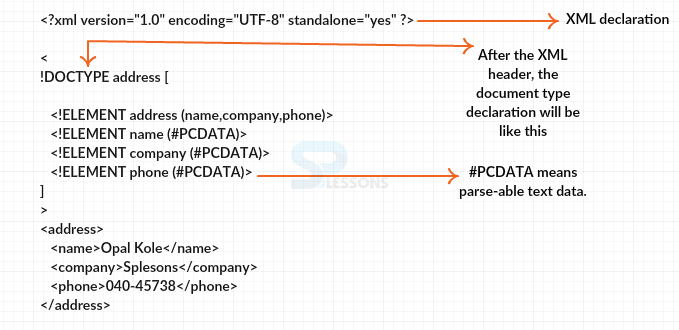 Description
Description
The xml report sort declaration, for the most part called dtd, dtd is a way to deal with depicting xml lingo for all intents and purposes. dtds check vocabulary and authenticity of the state of xml chronicles against syntactic ideas of appropriate xml lingo. a xml dtd might be either demonstrated inside the document, or it can be kept in a particular record and after that delighted in autonomously. taking after is the crucial punctuation of the dtd.
[xml]
<!DOCTYPE element DTD identifier
[
declaration1
declaration2
declaration3
........
]>
[/xml]
In which the dtd begins with <!doctype delimiter. dtd identifier is an identifier for the record kind definition, which is probably the way to a report on the framework or url to a document on the internet. on the off hazard that the dtd is indicating outdoor manner, it's miles called external subset. the rectangular brackets [ ] are inner subsets. an detail advises the parser to parse the document from the predetermined root element.
 "Description"
"Description"
The developer can compose manages inside XML record utilizing declaration. The extent of this DTD inside this report. Usage is archive approved independent from anyone else without outer reference. Following is the syntax.
[xml]<!DOCTYPE root-element [element-declarations]>[/xml]
In which root-element is not anything but the call of root detail. The subsequent is an instance.
[xml]
<?xml version="1.0" encoding="UTF-8" standalone="yes" ?>
<!DOCTYPE address [
<!ELEMENT address (name,company,phone)>
<!ELEMENT name (#PCDATA)>
<!ELEMENT company (#PCDATA)>
<!ELEMENT phone (#PCDATA)>
]>
<address>
<name>Opal Kole</name>
<company>Splesons</company>
<phone>040-45738</phone>
</address>
[/xml]
In the above case, #PCDATA implies parse-capable content information. Taking after is the picture depiction of the above code.
Following are the some rules need to be remind.
- The type of the document declaration must show up toward the begin of the report, it is not allowed anyplace else inside the archive.
- Like the DOCTYPE presentation, the component affirmations must begin with an exclamation mark.
- The Name in the report sort declaration must match the part kind of the root segment.
 Description
Description
External DTD is shared between numerous XML reports. Any progressions are redesign in DTD record impact or upgraded go to an all XML reports. External DTD will have two types as follows.
Private DTD distinguish by the SYSTEM keyword. Access for single or gathering of clients. The developer can indicates rules in external DTD document as .dtd type. Later in XML document presentation to connecting this DTD record. Following is the syntax declaration.
[xml]<!DOCTYPE root_element SYSTEM "dtd_file_location">[/xml]
Following is an example.
external_dtd.dtd
[xml]<?xml version="1.0" encoding="UTF-8" standalone="no" ?>
<!DOCTYPE address SYSTEM "address.dtd">
<address>
< <name>Opal Kole</name>
<company>Splesons</company>
<phone>040-45738</phone>
</address>[/xml]
address.dtd
[xml]
<!ELEMENT address (name,company,phone)>
<!ELEMENT name (#PCDATA)>
<!ELEMENT company (#PCDATA)>
<!ELEMENT phone (#PCDATA)>
[/xml]
Public DTD distinguishes by the PUBLIC keyword. Get to any clients and XML editors are know the DTD. Some normal DTD Web DTD, XHTML, MathML and so on. Following is the syntax.
[xml]<!DOCTYPE root_element PUBLIC "dtd_name" "dtd_file_location">[/xml]
Following is an example.
[xml]<!DOCTYPE html PUBLIC "-//W3C//DTD XHTML 1.0 Transitional//EN" "http://www.w3.org/TR/xhtml1/DTD/xhtml1-transitional.dtd">
<html xmlns="http://www.w3.org/1999/xhtml">
<head>
...
</head>
<body>
...
...
</body>
</html>[/xml]
 Key Points
Key Points
- The DTD is utilized to check the structure of the XML archive.
- The scope of internal DTD is with in the document.




